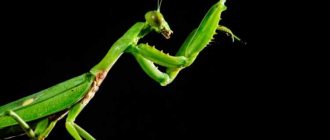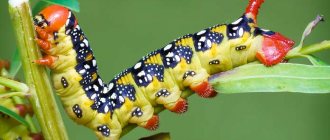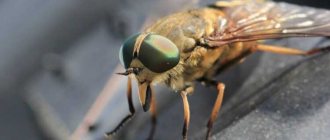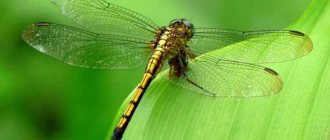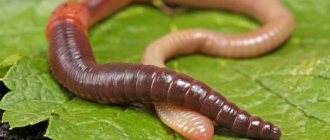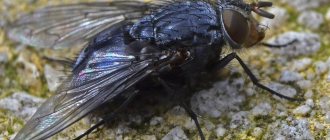- Wild animals
- >>
- Insects
Locusts are one of the most dangerous insects for the national economy. The pest of agricultural and wild crops is widespread throughout the planet. Once upon a time, in ancient times, locust raids not only destroyed crops, but could lead to starvation of an entire people. A single individual is completely harmless, but when it joins the ranks of a flock, it easily destroys all crops in its path.
Origin of the species and description
Photo: Locust
The locust is a gregarious insect of the true locust family. This large arthropod insect, part of the ranks of Orthoptera of the suborder Short-whiskered, reaches quite large sizes in growth from 1 cm to 6 cm. Some individuals in rare cases reach 14 cm in length. Females are much larger than males. The locust looks very much like a grasshopper. The color of locusts performs a camouflage function and can change depending on environmental factors.
Video: Locust
The word "locust" translated from Turkic means "yellow". The locust is an unpretentious and harmful insect that can be found in all corners of the planet, except permafrost. The harsh climate is not suitable for insect life. Locusts love warmth and sunlight. The average lifespan of a locust ranges from eight months to two years, and the insect can be in different life phases: the solitary phase and the gregarious phase.
The phases differ significantly from each other and affect not only the color of the insect, but also its behavior. There are a large number of locust species, up to ten thousand; the most dangerous are the Asian and migratory ones. Locusts are vegetarians and eat any green plants.
Interesting fact: As a result of friction against each other, the wings of locusts make a sound similar to creaking in flight. When a huge flock of insects flies, a sound is formed that resembles a strong hum, which can be heard over long distances. Some people mistake this sound for thunder.
Forms of development
The uniqueness of this insect is that it has 2 forms of development:
- single (filly) - a form of development with a sufficient amount of food;
- gregarious. When the food supply becomes scarce, the fillies unite in flocks and fly in search of food. At the same time, their appearance changes, the size of the body and wings increases, this occurs through the friction of individuals against each other by the limbs on which a special organ is located.
The fillies turn into locusts, a real disaster for people, huge hordes of which in a matter of days can devour the entire harvest in the fields, orchards and vegetable gardens. Along the way, the females lay eggs, from which the next year they hatch not into fillies, but into locusts.
Locusts are a real disaster for the world, a dangerous agricultural pest. In many countries there are so-called “anti-locust organizations”, one of the largest is in London, which are looking for methods to combat the “green plague”. But in some southern countries, locusts are considered a delicious food and are even bred in special incubators.
So, we have described the type and process of reproduction, and also answered the question: do locusts have a pupa?
Appearance and features
Photo: What locusts look like
By nature, the locust has an elongated body and six legs, two of which, namely the front ones, are weak. One back is longer than the other and many times stronger. In nature, there are individuals whose body length reaches fifteen centimeters. Typically, the body length ranges from 3 to 7 cm. The locust also has a large head with pronounced eyes.
The wings are transparent and practically invisible when folded and are covered with two solid elytra. Locusts are one of the oldest representatives of the Orthoptera order. There are about twenty thousand species around the world. The color of the locust depends only on the place where it lives and where it was formed. Therefore, specimens that appeared at the same time from the same female can be completely different colors, provided that they are raised in different conditions.
The appearance of locusts largely depends on the stage of their formation. The color of singles is a camouflage suit of green-yellow or walnut color. The shade depends entirely on the region of residence of such an insect. When a flock is formed, all its members become similar to each other. There are no differences between individuals, including no division by gender. Locusts can cover a distance of 200 km in a day. Some types of locusts are very similar to grasshoppers. Therefore, at first glance, it is difficult to recognize a pest in such individuals. A mistake in this case can be costly, especially for agricultural producers.
Therefore, you should pay attention to the signs by which it is easy to distinguish a locust from a grasshopper:
- the body of the locust is longer than the body of the blacksmith;
- the locust's snout is rectangular in shape, while that of the grasshopper is elongated;
- the locust's antennae are quite short in relation to its head;
- the front legs of the locust are much less developed than the hind legs;
- Grasshoppers are lovers of the evening cool, so they lead an active life in the evening. The locust, on the contrary, loves daylight very much, so it is active during daylight hours;
- grasshoppers never gather in flocks, while locusts, on the contrary, are most often found in the company of their relatives.
How to lime a pest
Insects gather in flocks of several thousand individuals. When burying clutches of eggs, individuals are particularly voracious. Lack of food leads to a decline in populations. Sudden changes in air temperature negatively affect their life.
Ways to deal with locusts include destroying clutches and using chemical insecticides that repel and poison insects.
Where do locusts live?
Photo: Locusts in Russia
There are a huge variety of locust species, and approximately six hundred of them live in Russia. Mainly in its southern regions. The steppe locust lives in Asia, North Africa, and Europe. There are also species living on the borders of the Sahara, the Indo-Malay Archipelago, New Zealand, Kazakhstan, Siberia and Madagascar. Large concentrations of individuals are also present on the Amu Darya River, Dagestan.
There are species that live in the northern regions, but their numbers are much lower. Locusts love dry and hot weather and settle in regions with similar weather conditions. Locusts have settled in almost every corner of the earth except Antarctica. It simply cannot survive in permafrost.
Fun fact: Locusts are not native to North America. Its last invasion here was at the end of the 19th century. After a fruitful fight against the pest, no locusts were seen in this area.
Today, locusts inhabit all climatic zones of the planet. Since it prefers warm climates, it is easy to find in tropical and subtropical regions. With all this, the locust is also a resident of Western Siberia. Each type of locust is suitable for certain comfortable living conditions. While one type of insect prefers to settle in thickets near water bodies, another species prefers semi-desert areas on rocky soil overgrown with sparse vegetation.
Now you know where locusts are found. Let's see what this insect eats.
Protection measures
To prevent and control locusts, the following measures are taken:
- To destroy the egg capsules of migratory locusts, deep plowing is used.
- To reduce the number of Asian locusts and reduce places suitable for laying eggs, a method is used to drain and further use the floodplains of rivers and lakes for growing crops.
- For chemical treatment of crops of various grain crops, in order to destroy the larvae, they are sprayed with pesticides: Karbofos, Fufan, Sumition, Sherpa; pastures and haylands are treated with the following preparations: Decis Extra, Fastak, Fury.
What do locusts eat?
Photo: Locust insect
The locust is endowed with a very powerful jaw, which allows it to absorb any soft and hard food. The structure of the oral cavity does not allow the insect to consume nectar or plant juice. She can only chew plants. At the same time, any plants are suitable for food.
The locust's diet depends on its phase. Single individuals feed moderately and do not cause severe damage to plantings. The appetite of such a locust allows it to eat no more than half a kilogram of greenery in its entire life. However, when locusts become part of a swarm, their appetite immediately increases significantly. In order to survive, an insect in a flock is forced to constantly absorb huge amounts of food. If the locust does not regularly replenish its energy balance and restore vitality, then it is doomed to die from thirst and protein deficiency.
The locust, which is part of the swarm, destroys all the greenery around itself, and can eat up to half a kilogram of green mass per day. If the food runs out, the insect turns into a predator and can begin to devour its relatives. The locust's appetite directly depends on the temperature level; the higher it is, the more greenery is eaten.
Interesting fact: A swarm of locusts eats everything except iron, stones and synthetics. The insect's favorite food is reed vegetation.
After a swarm of locusts attacks green spaces, the ground is left almost bare.
Insect diet
For the most part, locusts spend their time on leaves, flowers, and grass. Locusts are the most vegetarians without any obvious food preferences. Most species do not care what kind of crop it is - wild or agricultural. They feed on the leaves of plants, trees, shrubs, and all ground parts of plantings. Only some species prefer herbaceous plants. During its life, an insect eats an average of 300-350 g of plant mass, and the daily volume is twice its own weight.
For some species, poisonous plants serve as food. As toxic components accumulate in the locust's body, it becomes poisonous. These individuals are characterized by bright, flashy colors, which seem to warn of the danger of everyone who wants to feast on locusts.
When insects gather in swarms, what the locusts feed on depends on the objects that come across its path. In this case, even thatched roofs and reeds, not to mention vegetables, grains, and melons, can be eaten. As eyewitnesses say, during insect attacks, locusts only devour bricks and iron.
The insect is bred as food for various exotic animals. Therefore, the question of what locusts eat at home does not surprise anyone. In insectariums they are fed twice a day with grain, green herbs, and some owners even prepare sprouted wheat for their pets.
Features of character and lifestyle
Photo: Large locust
The peculiarity of locusts is that they are able to live both on their own and in huge swarms. When the locust lives alone, it does not have a huge appetite and moves relatively little. It is not dangerous and does not cause much damage. As soon as the food runs out, the locusts try to lay as many eggs as possible, from which they will later hatch into gregarious individuals that can and will move long distances.
The offspring will be larger than their parents, their wings will be more powerful, which means they will be able to move longer distances. In swarms, locusts are very mobile and incredibly voracious. Flocks can number half a million. In order for the hatching of swarming individuals to begin, a deficiency of organic substances and amino acids must form in the locust’s body, and the reason for this may be a dry year and a lack of food.
Interesting fact: The well-developed hind limbs of the insect allow it to move in one jump over distances whose length exceeds the size of the locust’s body by tens of times. A walking herd of locusts can cover a distance of 20 km during daylight hours.
A swarm of locusts is an organized system that moves purposefully at the call of fear and hunger. An adult can walk, jump and fly. However, her most efficient way of moving is by flying. A tailwind helps the locust move much faster, saving its strength.
Control measures
Given the speed of movement, gluttony and complete destruction of green plants along the route of the swarm of locusts, chemical control measures are used to destroy them, especially over large areas.
In a country house or local area, the fight against locusts is mainly preventive and proactive and begins with agrotechnical measures, the thoroughness and timely implementation of which helps to significantly reduce the number of pests and prevent epiphytotic damage to the green world of plants.
To prevent agricultural disasters, the number of insects at different stages of development of migratory locusts is monitored in breeding areas.
Such accounting makes it possible to predict the appearance of the gregarious form and apply insecticides in the phase of population growth, including barrier treatment of nesting sites.
The biological enemies of locusts are insectivorous mammals and birds (especially starlings), as well as some fungi that are pathogenic for orthopterans.
Agrotechnical prevention of the growth of the Asian locust population is:
- Drainage of floodplains of rivers and lakes using them for agricultural plantings.
- Improvement of pastures by mass sowing of forage grasses. The soil, densely entwined with roots, becomes unsuitable for laying eggs.
- Deep plowing of areas infested with locusts, turning over the earth layer and harrowing.
- Spring disc loosening along roadsides and slopes of irrigation canals.
Asian migratory locust (family name - locusts), type of development - indirect. During the period of mass reproduction, this pest poses a real threat to all agricultural crops.
The rise in the number of these insects can be prevented by agrotechnical and biological prevention, as well as timely treatment of breeding sites with insecticides.
Social structure and reproduction
Photo: Large locust
Locusts lay eggs and reproduce sexually. To attract a female, the male uses a specific hormone (produced by the male when he vibrates his wings), and the female, in turn, chooses the male based on the smell she likes. After she discovers a male, she tries to get as close to him as possible. The male lightly touches the partner a couple of times with his antennae, and after that he attaches himself to the female and tries to deposit a special capsule with sperm in the back of her abdomen.
This is a rather labor-intensive and time-consuming procedure, so the approximate mating time is 13 hours, but it can happen faster. After mating, the female buries the ovipositor in moist soil, covering it with a special foamed liquid, which, after hardening, turns into a hardened cocoon. The average number of eggs in one clutch ranges from 60 to 80 eggs. Throughout her life, the female makes from 6 to 12 clutches, which on average equals four hundred eggs. After twelve days, white larvae simultaneously emerge from the eggs, which after birth begin to actively eat and grow.
In order to get out of the capsule, the larvae require a lot of effort and time. As soon as the larvae hatch, they molt and release their limbs. The locust larva is very similar to the adult, it is only much smaller and lacks wings. After experiencing several stages of development, the larva becomes an adult locust after 35–40 days, undergoing five moults.
Natural enemies of locusts
Photo: What locusts look like
Nature has it in such a way that locusts are also food for other living beings. This is due to its great nutritional value, as it contains a lot of protein, fat and phosphorus. The main enemy of the insect is birds. Birds not only eat adult individuals, but also destroy their eggs, pecking them out of the ground. Similarly, locust eggs are destroyed by pigs, moles and shrews. Spiders do not disdain such food either.
Mantises and other mammals that feed on small insects also hunt for locusts. Locusts are eaten by various ungulates, such as zebras, giraffes and roe deer, as well as elephants and lions. Many pets will also not refuse to eat a tasty treat in the form of locusts. It is worth noting that the locust itself does not mind eating its fellow creature if there is no other food left.
Interesting fact: People also eat locusts, both cooked (fried and boiled) and raw. Flour is made from locusts previously dried by the sun's rays and ground into dust, which is added to milk or fat during baking.
There are a number of parasites that also destroy locusts:
- blister bugs and fungi destroy locust eggs;
- viviparous flies and hairworms infect the locust's body from the inside.
Creators of Fertility
It is the gregarious species of locusts that cause the main damage during the years of outbreaks of their numbers, destroying almost all green parts of plants along the way. But also their non-herd relatives (which are often called fillies
and
skates
), as well as their distant relatives from the order Orthoptera, can also reproduce in large numbers and destroy plant cover both in natural ecosystems and in fields.
But should these insects be considered just a punishment for humanity? In fact, as herbivores, they are an essential element of food webs in grassland ecosystems, primarily in steppes, prairies, semi-deserts and savannas. This not so obvious role of theirs was noted in the biblical texts: “What was left of the caterpillar was eaten by locusts, what was left of the locust was eaten by worms, and what was left of the worms was eaten by beetles” (Book of the Prophet Joel, 1, 4).
The famous Siberian entomologist I.V. Stebaev back in the early 1960s. showed that in the temperate latitudes of Eurasia, locusts during the warm season can consume over 10% of the green phytomass of grasses. In addition, they actively use litter for food, and if there is a lack of plant food, they are able to switch to the corpses of their fellows, the excrement of other animals, etc. (locusts can even eat textiles and leather goods!). One average individual of the Siberian steppe locust consumes approximately 3–3.5 g of green parts of plants during its entire life, which is approximately 20 times its adult weight (Rubtsov, 1932). Slightly higher figures were obtained for North American and South African locusts.
Such gluttony of these insects paradoxically turns out to be a blessing for natural communities. Thus, Stebaev and his colleagues found that locusts contribute to the destruction and rapid return of plant mass to the cycle of matter and energy: in the intestines of many steppe locust species, the leaves and stems of cereals are not so much digested as crushed and fragmented, and symbiotic intestinal microorganisms enrich these fragments B vitamins. As a result, locust excrement is converted into an excellent organic fertilizer. In addition, Canadian researchers have shown that locusts, by eating leaves, activate plant growth and increase their productivity.
Thus, despite the fact that the damage caused by locusts and other orthoptera can be enormous, their role in ensuring the normal functioning and sustainability of natural ecosystems, especially herbaceous ones, is colossal.
